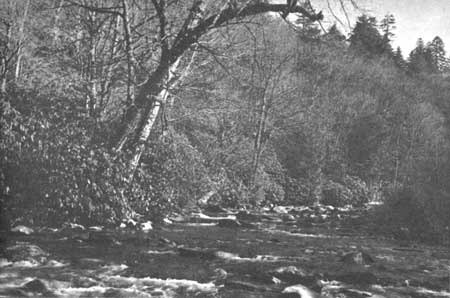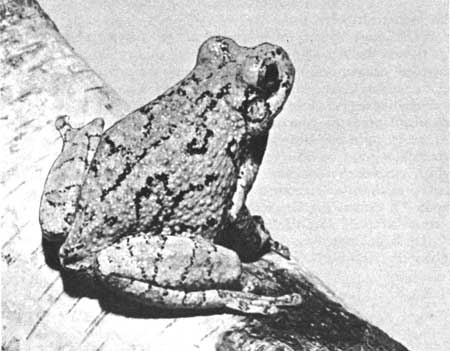|
GREAT SMOKY MOUNTAINS National Park |
 |
Salamanders, Toads, and Frogs
The southern Appalachian Mountains have long been regarded as the home of a large variety of amphibians. It is an ancient region of heavy precipitation and numerous streams and rivulets. Within the National Park alone the vertical distance between the lowest and highest points of land is almost 5,800 feet. The plant-life is dense and rich in the number of species; here one finds Canadian-zone stands of spruce and fir on the higher summits grading down to sweetgum and sycamore at the base. These mountain forests are the habitat for at least 27 kinds of salamanders, ranging from the pigmy salamander, less than 2 inches long when mature, to the big hellbender, which may grow to 29 inches. The pigmy salamander is strictly terrestrial and is found only in the high-mountain forests, whereas the hellbender is entirely aquatic, living only in the warmer low-altitude streams.
The red-cheeked, or Jordan's, salamander is of exceptional interest, since its entire range appears to be restricted to Great Smoky Mountains National Park. Adults average about 4 inches in length. With the exception of reddish or orange cheek patches, the coloration throughout is blackish. Like the pigmy salamander, the first specimens of which were discovered in the Smokies, Jordan's salamander is a land form, living under rocks and logs at the higher altitudes.
While most species of salamanders will lay eggs during the spring, the hellbender will lay her string of eggs in summer; the marbled salamander, in the autumn; and the attractively marked spotted salamander, in the winter. It is not unusual to find the jellylike egg-clusters of the spotted salamanders in temporary woodland pools in January.
 Numerous streams and rivulets make this region the habitat for many salamanders. This stream is the West Prong of the Little Pigeon River. |
On certain warm rainy nights in early spring, large numbers of salamanders may be observed upon the wet macadam-surfaced road which crosses the Smokies from Cherokee, N.C., to Gatlinburg, Tenn. Such an emergence is described by Dr. Willis King in his report "A Survey of the Herpetology of Great Smoky Mountains National Park." (See "Selected Bibliography.") In his discussion of the large mountain purple salamander, which occurs mostly at altitudes above 2,500 feet, Dr. King writes:
On the night of April 20, 1937, Mrs. King and I were driving from Gatlinburg to Waynesville between 8 and 9 p.m. It was a warm foggy night, following a period of showers. On the Newfound Gap road, Tennessee side, between 3,500 and 5,000 feet elevation we saw at least 200 salamanders of this species crawling about on the road. They could be seen at considerable distance because of the contrast of their light bodies on the black surface of the road, but even more striking was the reflection from their eyes. The presence of so many of these comparatively uncommon animals made the observation all the more interesting.
Although an emergence of salamanders in April appears in order, as many as eight species of amphibians (five salamanders, two frogs, and a toad) have been observed on this same road on a wet night in November, and nine species (five salamanders, three frogs, and a toad), on a day and night in December. On the latter occasion (December 3, 1950) three specimens of mountain purple salamanders which had been killed by passing vehicles were collected; one of these was a female with a large quantity of eggs in the body cavity. How soon would these eggs have been laid if the animal's life had been spared? Much remains unknown concerning the natural history of a number of our salamanders.
The presence of these amphibians at night on the wet, macadam-surfaced road may be due, in part, to the temperature and, in part, to the food which is available there. Roads of this kind are likely to be warmer than the ground on either side and, when wet, serve to attract a considerable number of earthworms and other small invertebrates, where they are readily secured by the salamanders. But such a situation is hazardous to all concerned, for not only passing vehicles but various predators kill the slow-moving salamanders once they leave the protection of the nearby forest. Since the remains of salamanders have been found in the stomach of a screech owl, and since screech owl remains have been found in the stomach of an opossum—both the owl and the opossum having been killed by passing cars along the road—a chain reaction such as the following is within the realm of possibility.
The setting is the main transmountain road in the Great Smokies on a warm, rainy night: (1) Earthworms become stranded on the road; (2) a salamander appears and begins feeding upon the earthworms; (3) a screech owl, while patrolling the road, discovers the salamander and alights to feed upon it; (4) a passing car kills the owl; (5) an opossum finds the dead owl in the road and, while feeding upon it, meets a similar fate. One could go on and extend the chain with a fox feeding upon the opossum, but since Reynard in all probability would carry the opossum into the nearby woods before beginning his meal, the sequence will end there.
 The snoring drone of the gray treefrog is one of the late-spring and summer sounds in lower altitudes of the park. Courtesy, Isabelle Hunt Conant. |
The American toad, Fowler's toad, and 10 species of frogs occur within the park. Unlike the salamanders, which are voiceless, frogs and toads are well endowed in this respect, and their singing may be loud and persistent. These animals are the first to give voice to the coming of spring, and this may be as early as January in the case of spring peepers, chorus frogs, and wood frogs. Egg-laying commences soon thereafter. Toads lay their eggs in long strings, while frogs lay theirs in gelatinous masses. Only the American toad, spring peeper, and the gray treefrog occur at high altitudes in the park, and these are uncommon there.

|

|
|
|
|
Last Modified: Sat, Nov 4 2006 10:00:00 pm PST |


